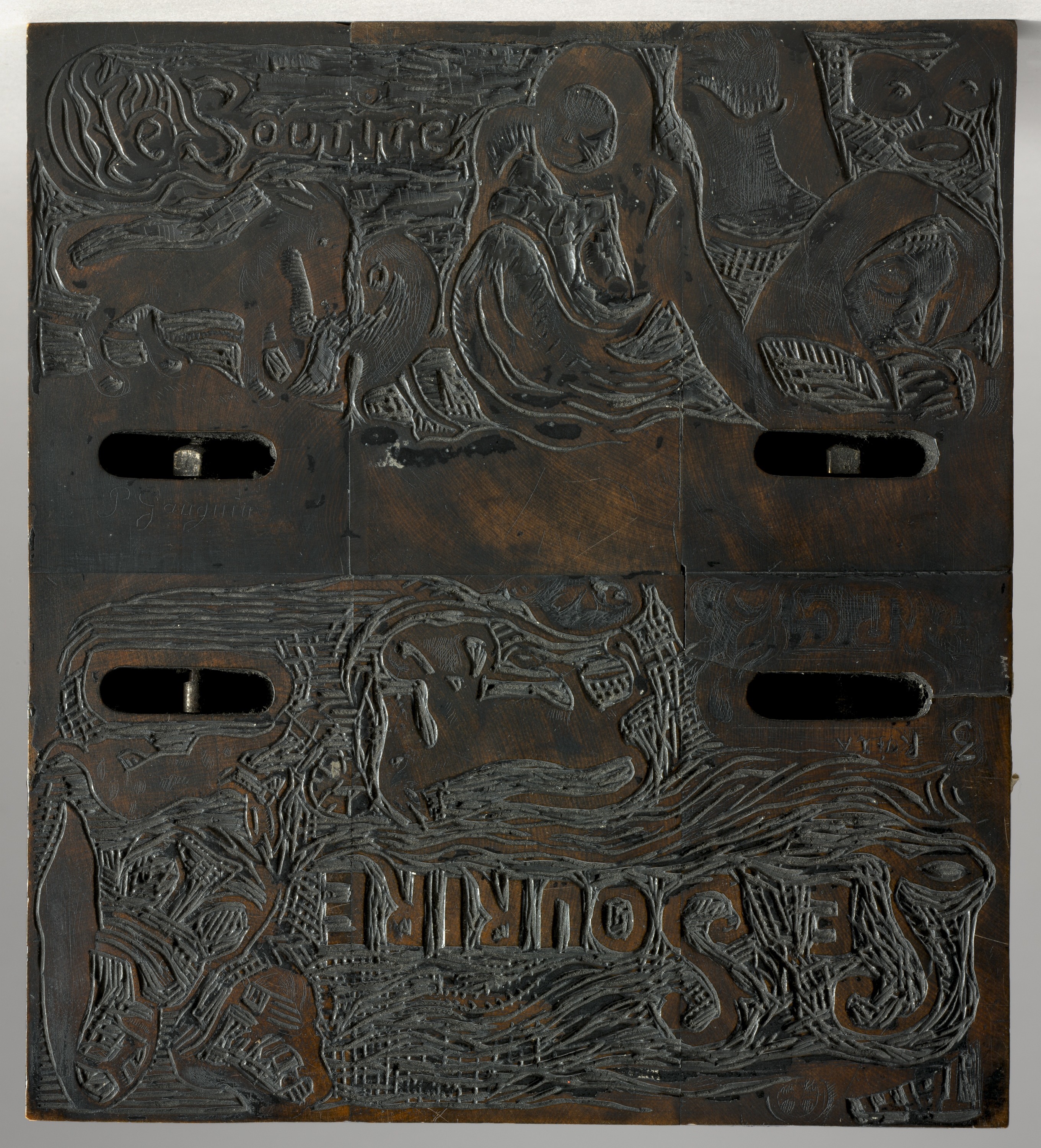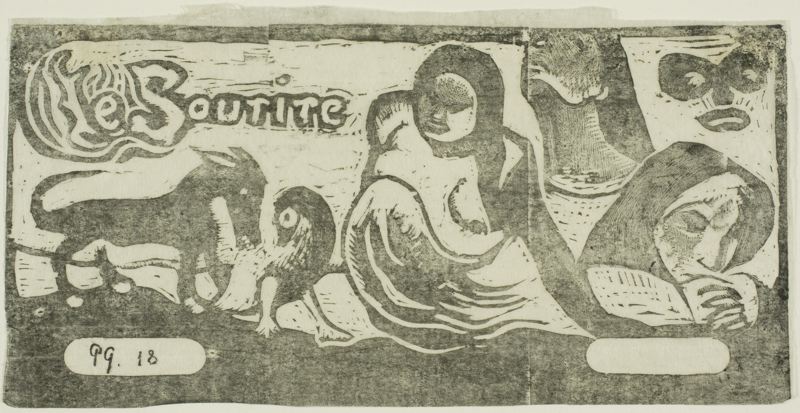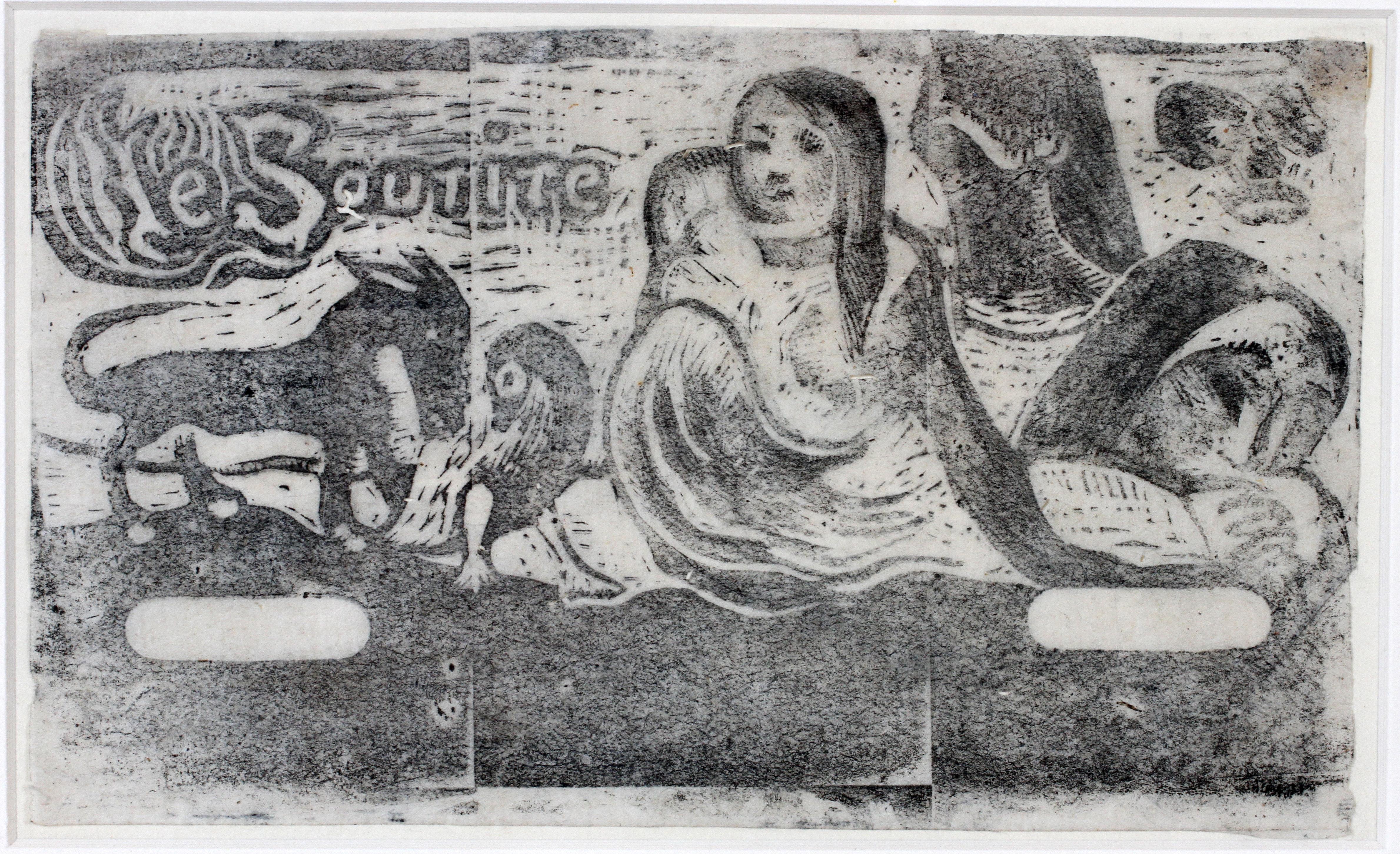|

|
|
Le Sourire (Titre)
Guérin 75, Mongan,
Kornfeld, & Joachim 58
woodcut, 1899, on fine ivory Japon
paper, the exceedingly rare first state*, a superb working impression, printed in
greyish-black, probably by the artist himself
An early working impression, before the sole edition of
about 30, irregular margins, trimmed to the block on three sides, small margins below),
a few
small printing creases, traces of pinkish pigment visible upper left in
transparency and on the reverse, a small piece of brown wrapping paper
stuck to the upper right corner, otherwise in very excellent condition
B. 103 x 182 mm., S. 111 x 181 mm.
|
Provenance: a private American
collection
During Gauguin's second
stay in Tahiti, he published a short-lived, mimeographed journal,
titled Le Sourire** (The
Smile), cutting and printing by hand the headpiece for each issue; it
is estimated that the print runs were less than 30, most of which were
subsequently discarded (according to Bouge, there are only two known complete
collections of this ephemeral work)
The first state, as yet
undescribed, is of the utmost rarity.

Given their extensive
expertise in Gauguin prints,we have researched the present impression
at the Art Insitute of Chicago, in September 2013, as follows;
The
Art Institute of Chicago holds four impressions of Paul Gauguin's
woodcut title for Le Sourire,
MKJ 58:
- one impression of the journal
itself, with the woodcut rather carelessly printed as the headpiece
(catalogue n° 1948.418-423);
- two impressions of the initialed and
numbered ("10" and "18"), tiré à part
edition, on tissue-thin Japan paper (catalogue n° 2002.243
and 1946.33);
- one impression of the posthumous
edition, printed by Pola Gauguin in 1921 (catalogue n° 1924.1194).
Harriet Stratis, with Nancy Ireson and myself, first conducted an
overall visual examination of the five prints (along with a photograph
of the original double woodblock, now in the National Gallery of Art,
Rosenwald Collection, 1943.3.1726.b, left), including a physical overlay to
confirm imprint identity. This included an evaluation of the
layout of the blocks that composed the original work, as well as a
clear correspondence with the inverted woodblock for MKJ 69, partially
visible in the lower register. There are also detailed striations
in the countenance of the outward-looking seated figure that map onto
the reworked features.
Subsequent to this, it was suggested by Peter Zegers that it would be
worthwhile to examine this anomalistic impression with the n° 18
impression (right) from the tiré à part
edition more closely, for two reasons:
- the inking of this impression was qualitatively much
closer than that of the darkly-inked impression of n° 10, and notably
- on the card mount of this print , there was a
hand-written annotation (anonymous and undated, but clearly resulting
from an earlier curatorship of the AIC):
"There is a later state
in which the seated figure looks out at the spectator."
This was of course quite intriguing. Someone in the AIC had seen
an equivalent impression, if not the one at hand...
Given that the central seated figure (with a glowering and downcast
countenance on the original woodblock in the Rosenwald Collection) is
consistent with that of all of the known impressions (Mongan, Kornfeld,
and Joachim identify only one state), it would evidently appear that
this could not be a later state, but rather an un-described early state
(1st state?) of the print, as attested e.g. by the printed matter
between the throat of the upward-looking head and the shoulder of the
seated woman that was later removed.
Thus, contrary to the annotation on the mount of the impression in the
AIC catalogued as 1946.33, this could not
be a late impression, as attested by the original woodblock itself.
Furthermore, studied close-up examination (under a Leitz binocular
microscope) of the two prints revealed a clear consistency over the two
impressions, although the fine incising that was apparent in the
published state (notably on the uplifted head to the right) had not yet
been added.
The conclusion is quite simply that the present impression represents
an early undescribed state of the woodcut, probably a working proof
(further corroborated by the rather weak-greyish tint of the inking, as
if the artist casually pulled an impression, simply wishing to monitor
his progress).

* This state is not described
by either Guérin or Mongan, Kornfeld, & Joachim.
** Gauguin outlined his
editorial project quite clearly:
"Hommes
graves souriez, le titre vous y invite. Tant de délassement personnel,
tant de classement d'idées aimées, quoique folles peut-être ; je rédige
Le Sourire. Informes et indécis, l'oeil proche, ces écrits au recul et
à l'examen deviendront précis si vous le voulez. Je ne vous dirai pas
la vérité, tout le monde se vante de la dire ; la Fable seule indiquera
ma pensée si toutefois Rêver est Penser - maintes fois aussi un dessin,
quelques traits seulement..."
"Serious Men, kindly smile, as the title prompts. Both as
personal entertainment, and in ranking beholden, yet perhaps foolish
ideas, I write Smiling. Shapeless
and indecisive to the close eye, these writings, in retrospect and
review become clear if you so wish. I will not tell you the
truth, everyone brags about saying such; only Fable will reveal my
thoughts, if yet Dreaming is Thinking - again as a drawing, only a few
lines ... "




